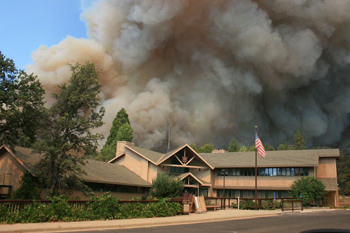By John-Miguel Dalbey
In California, wildfires and forest fires are a yearly occurrence. Already, the warm, dry Santa Ana winds have stirred up fires in both Kimball Island, between Sacramento and San Francisco, and Jurupa Valley in Riverside County. The first fire resulted in no casualties and only one destroyed building, while a second burned down several homes and other small structures according to State Fire Captain Lucas Spelman, quoted in the Huffington Post. No injuries or deaths were reported, other than the sad loss of two pet dogs. As the current combination of dry spells and winds continue, more wildfires are expected.

Coinciding with the drought, the Bureau of Land Management had its budget cut 47 percent, leading to a loss of half its forestry staff. As a consequence, many related projects, while funded, are left unmanned. In particular, the Mother Lode Field Office in Folsom, Calif., has lost a major portion of its staff, leaving the 200,000 acres of forest and woodlands vulnerable to wildfire. Specifically, the office’s Giant Gap Stewardship project lacks the workforce to complete its goals. The project area, 150 acres of mixed conifer west of Iowa Hills, above the North Fork of the American River, has been identified in the Iowa Hills Community Protection Plan is in need of commercial thinning to reduce the high risk of fire in the area. A local landowner with property bordering the area has already taken steps to thin the forest on his land and has approached the BLM requesting that the surrounding area be made less fire prone in order to protect his property. While the BLM had completed 80 percent of a planned shaded fuel break for the area in early 2011, budget constraints have since prevented the hiring of a head forester for the project. Due to the combined absence of staffing and funding, this project remains uncompleted, leaving the local forest and community vulnerable.
Fire plays many important roles in our forests, but can sometimes be too frequent or too intense for forests to recover from without help, especially as climate change takes its toll. Wildfire can contribute to climate change and carbon emissions through the burning of large amounts of biomass. This may create a “positive feedback loop,” in which the absence of trees and increased CO2 lead to more extreme droughts and winds, which in turn lead to worsening fires in a vicious cycle. For this reason, American Forests undertakes forest restoration projects following forest fires, many of which are in areas of California. Such projects are vital to the continued wellbeing of national forests and wildlife areas and the global ecosystem as a whole. Reintroducing trees to recently burned areas as soon as possible helps to reduce erosion and buildup of ash or soil in waterways, and aids in the rapid reintroduction of displaced wildlife. Planted trees also aid in absorbing particulate matter and CO2 emissions created by fires, offsetting some of the damages.